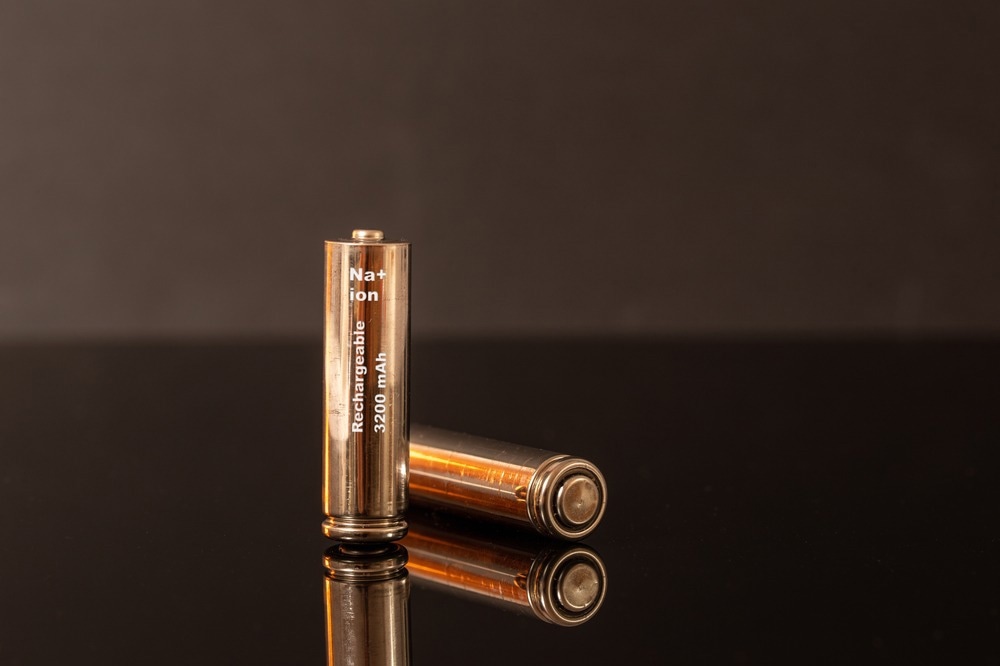Sustainability is key to the design of advanced batteries that can help address the issues associated with fossil fuel use. In order to investigate how sustainable sodium-ion batteries cathodes are, a new paper, authored by scientists from Germany and Spain, has been published online in the journal Advanced Energy Materials.

Study: Prospective Sustainability Screening of Sodium-Ion Battery Cathode Materials. Image Credit: gcarnero/Shutterstock.com
Batteries: A Key Electrochemical Energy Storage Solution
Batteries are a key electrochemical energy storage technology, along with fuel cells and supercapacitors, which can help to decarbonize industry and society and address the challenges of anthropogenic climate change.
Lithium-ion batteries are the most widely known and employed battery variants, finding successful applications in key industries such as transportation, where they power hybrid and electric vehicles. However, lithium-ion batteries, whilst they reduce carbon emissions, are not without their issues.
The extraction of lithium from natural deposits is a highly intensive process and has been associated with ecological damage and societal issues, especially in developing nations where the majority of lithium is recovered. Furthermore, resource scarcity, high cost, and vulnerability to geopolitical influences make the recovery and utilization of lithium for battery applications highly problematic.
Sodium-ion Batteries: An Emergent Battery Technology
Sodium-ion batteries have emerged in recent research as suitable candidates to replace lithium-ion devices due to their use of cheap, abundant, and non-environmentally harmful resources. These batteries are considered to be a viable “drop-in” technology. Additionally, there is a wide range of potential cathode material candidates for use in sodium-ion batteries.
In these systems, where sodium can be utilized as both active materials and electrolytes, there exists the possibility of replacing copper with aluminum as the current collector. Whilst sodium has a larger ionic radius and a lower standard electrode potential than lithium, which leads to reduced energy densities, sodium-ion batteries can be used in similar application fields, and already several companies are commercializing them.
Cathode-active materials with high energy densities and extended lifetimes are crucial for the commercial development of sodium-ion batteries, much like lithium-ion variants. Additionally, cathode active material selection can influence the cost, sustainability, and final application of these systems.
The Study
Whilst there are several well-research cathode active materials for lithium-ion batteries, research into these critical materials is less mature, with several material combinations being currently evaluated. Materials are being assessed in terms of energy density, cost, coulombic efficiency, cycle lifetime, sustainability, resource availability, and cost. However, many of these studies concentrate on technical and performance aspects.
The current paper in Advanced Energy Materials aims to critically assess the sustainability of currently proposed cathode active materials for commercial sodium-ion batteries. Over forty material compositions have been screened to provide a brief but comprehensive overview of any potential sustainability hotspots in current sodium-ion battery research.
The screened materials have been benchmarked in the study against state-of-the-art cathode active materials utilized in lithium-ion batteries. Cost, carbon footprint, and material criticality have been considered in this benchmarking. A tentative ranking of candidate cathode active materials has been made by the authors in terms of their sustainability and suitability for sodium-ion batteries.
Candidate Materials
Two main classes of state-of-the-art sodium-ion battery cathode active materials have been highlighted in the paper. The first type is the layered oxides, which are widely applied in lithium-ion batteries and have been evaluated in lab-scale studies for sodium-ion batteries.
The second group is polyanionic materials. This group includes Prussian Blue Analogs, which can be made from abundant materials and can be synthesized under low-temperature conditions. Polyanionic materials possess some advantageous properties, such as their high thermal stability and high redox potential. However, they display low electrical conductivity.
Material Selection
An exhaustive literature screening combined with workshop input was used to screen materials, which were categorized into layered oxides and polyanionic materials. Composition and properties were obtained from the literature review, which was complemented by experimental data and stoichiometric calculations.
Impacts such as raw material criticality, cost, and environmental impacts were evaluated, providing a critical overview of sustainability issues and allowing the numerous proposed cathode active materials to be ranked in the study. Key factors such as absolute risk scores were included in this ranking.
Study Findings
Multiple factors were considered in the study, including the concentration of reserves in specific locales, with particular problems identified in developing nations in terms of abundance, socioeconomic issues, pollution, geopolitical instability, and global supply. Other sustainability indicators including recyclability and carbon footprint were highlighted, alongside technical perspectives on materials.
The screening approach developed by the authors can be applied to early-stage development and can identify any potential material-related hotspots. Generally speaking, most sodium-ion battery cathode active materials perform well in relation to lithium-ion battery benchmarks in terms of cost, criticality, and carbon footprint.
Cobalt, vanadium, and nickel-containing materials have clear disadvantages, but the screening has identified manganese-based materials and Prussian blue as the most suitable candidates in terms of sustainability. However, the energy density of materials is another key factor that determines overall material demand, which will have impacts on materials in terms of the identified sustainability factors.
The authors have identified that their screening method possesses simplifications and required assumptions which leads to a high degree of uncertainty. The findings should not be used for decision-making, but rather should be used to identify potential sustainability hotspots. These findings should be considered highly explorative, although they are extremely useful for more detailed follow-up analyses.
More from AZoM: Exploring Thin Films and Coatings with AFM
Further Reading
Baumann, M., et al. (2022) Prospective Sustainability Screening of Sodium-Ion Battery Cathode Materials Advanced Energy Materials [online] onlinelibrary.wiley.com. Available at: https://doi.org/10.1002/aenm.202202636
Disclaimer: The views expressed here are those of the author expressed in their private capacity and do not necessarily represent the views of AZoM.com Limited T/A AZoNetwork the owner and operator of this website. This disclaimer forms part of the Terms and conditions of use of this website.